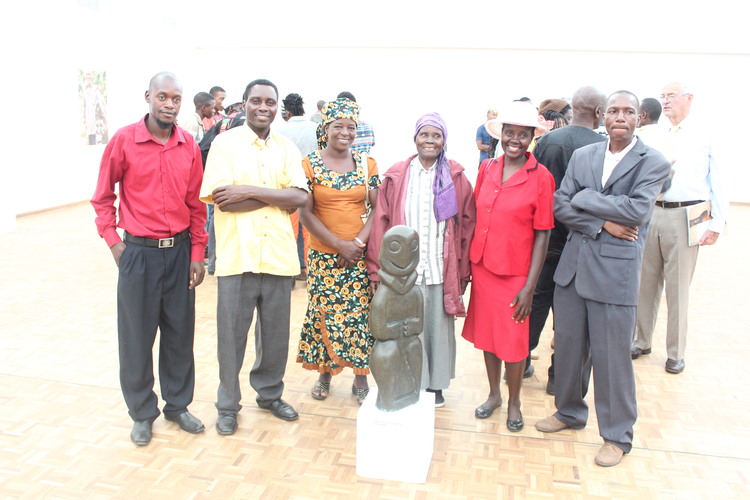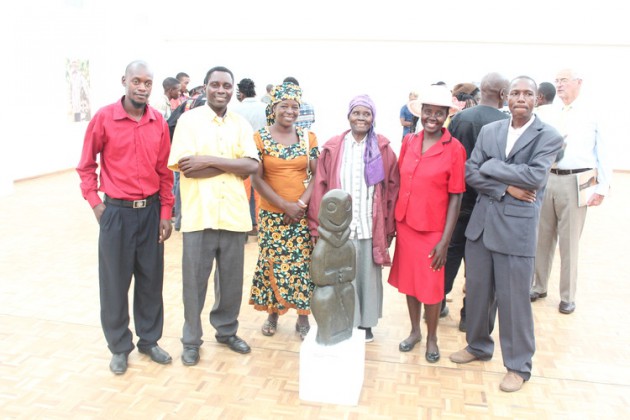‘Achikulile’: Tribute to great artist Malola

At the Gallery
History is the study of the past that helps us understand the present and the future. It is through history that we acknowledge some of the greatest achievements by people who contributed to our socio-cultural, economic and political development. In this era of globalisation, people, especially the young generation are losing sight of our history and cultural heritage. One sign of a healthy community is its simultaneous ability to preserve and invent its culture; that is to conserve its history and heritage while developing new expressions for current times.
It is therefore important for the media, education and social institutions conserving our history like art and history museums to inspire people and cultivate the spirit of those older moral conservative values that preserve our culture and heritage.
Paying tribute, acknowledging and celebrating those who have contributed in significant way is one way to motivate the young generation to look up to them and inspire them to emulate the legacy left by these great luminaries.
Even though some of them may no longer be with us we need to recognise them for the tremendous work they did on planet earth.
Just two years ago a sombre atmosphere engulfed Tengenenge Arts Community as artists and the community members were paying their last respects to one of the oldest sculptors in the country Amali Malola, who died at the age of 105.
He was one of the artists who was instrumental and led a young crop of sculptors in the community. Malola was dedicated to the preservation of Zimbabwean culture and heritage through stone sculpture.
In the spirit of celebrating the 60th Anniversary, the National Gallery of Zimbabwe is proud to present a long overdue tribute to Amali Wasili Malola, one of the early sculptors of the Tengenenge Art Centre.
Amali Malola’s prolific contribution to Zimbabwean stone sculpture inspired the conception of this exhibition.
The National Gallery of Zimbabwe is happy to stage this show as its first exhibition of 2017.
This exhibition marks two years since the death of this veteran artist. In a sense this tribute exhibition is fitting as the National Gallery of Zimbabwe this year is celebrating its diamond jubilee.
There are many artists that have come and gone who have contributed to the history of this institution. Malola is one such artist.
Born on the 6th of December 1921 in Mulembe, Malawi. In 1949 he immigrated to Zimbabwe in search of employment.
Malola started sculpting in 1969. His sculptures often represent figures based on funny but mostly true stories.
In the late 1960s the world recognised that a new art movement had been born in Africa and collectors started snapping up work.
Stone Sculpture first became popular in the United Kingdom, Holland and Germany.
More recently other European countries, the US and Australia have hosted exhibitions of stone sculpture and galleries specialising in the work have opened in the many major cities.
The stone sculpture movement laid the foundation for Zimbabwean contemporary art through artists like Amali Malola.
In 2003 Malola won in a competition in Harare and twice in exhibitions that were held by the Korean Embassy at Tengenenge in 2005 and 2006.
Despite his advanced years, his passion for art did not slow down, he would regularly visit his gallery and continued teaching the young crop of artists that are emerging in the village.
When Amali Malola died aged 105 years, he was still active in sculpting and was a pillar of strength for the artists in the Tengenenge community.
“Achikulile: Amali Malola’s” tribute show takes in a variety of works from the National Gallery of Zimbabwe collection, Amali Malola’s family collection and the Chapungu collection.
Malola used to sculpt from a conviction as an artist that he had a message to impart and he continued to deliver from his heart full of stimulating ideas until he passed.
He worked with some of the outstanding sculptors including, the late Moses Masaya, the late Bernard Matemera, Sylvester Mubayi, the late Henry Munyaradzi, the late Fanizani Akuda, Josia Manzi, Ndale, and Kakoma Kweli.
Without artists there would be no exhibitions. Many are familiar with Amali Malola’s work through local and international exhibitions of his sculptures.
His sculptures exhibit a firm distinction between beauty in nature and beauty in art.
This fundamental contrast, once grasped, enables us to begin to look at both art and nature with more understanding and appreciation. Art is there because the curve has pleased the artist and as viewers we can dislike or like the show.
“I am very happy and I would like congratulate the National Gallery of Zimbabwe for managing to host the tribute show because it was something that we had been discussing for a long time, considering that Amali Malola made a huge contribution towards the development of Zimbabwean modern art.
“We learnt a lot from him as he inspired us as artists,” said Mr. Dominic Benhura the director at the Tengenenge Arts Community.
He added: “It is important to pay tribute to artists like Malola because through their work they have managed to record and document our movement and growth as a nation from the colonial era and after attaining National Independence.
“It is also important to the young generation as it shows them that dedication and passion are two important things that one need in order to succeed in life.
Malola was dedicated and had so much passion for the arts until the time of his death, he was successful not only for himself but for the nation as a whole through mentoring young artists.”
As we continue celebrating the diamond jubilee, there will be more shows of Zimbabwean contemporary and African Art, and greater artist engagement through concerts and other public programmes.
The Gallery has already begun preparations for its fourth edition at the Venice Biennale which will be yet another exceptional moment in the National Gallery’s Endeavour to promote Zimbabwean art and culture on the international art scene.
One of our highlights this year will be the International Conference on African Art and Cultures from September 11-13, 2017 in Harare at the National Gallery of Zimbabwe.
This event will bring together local and international delegates in the art, culture and heritage industries to deliberate important issues surrounding the future and history of art and culture from Africa.







Comments